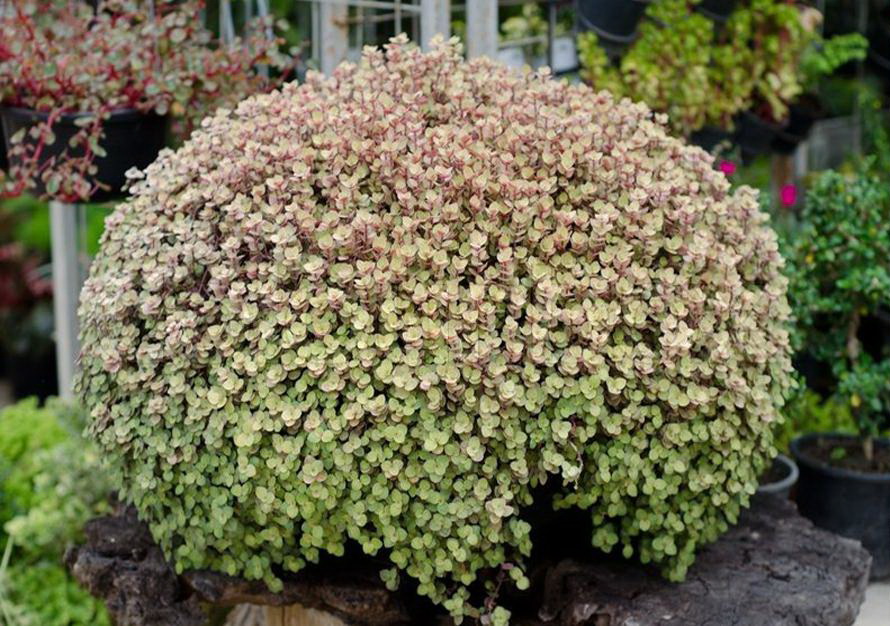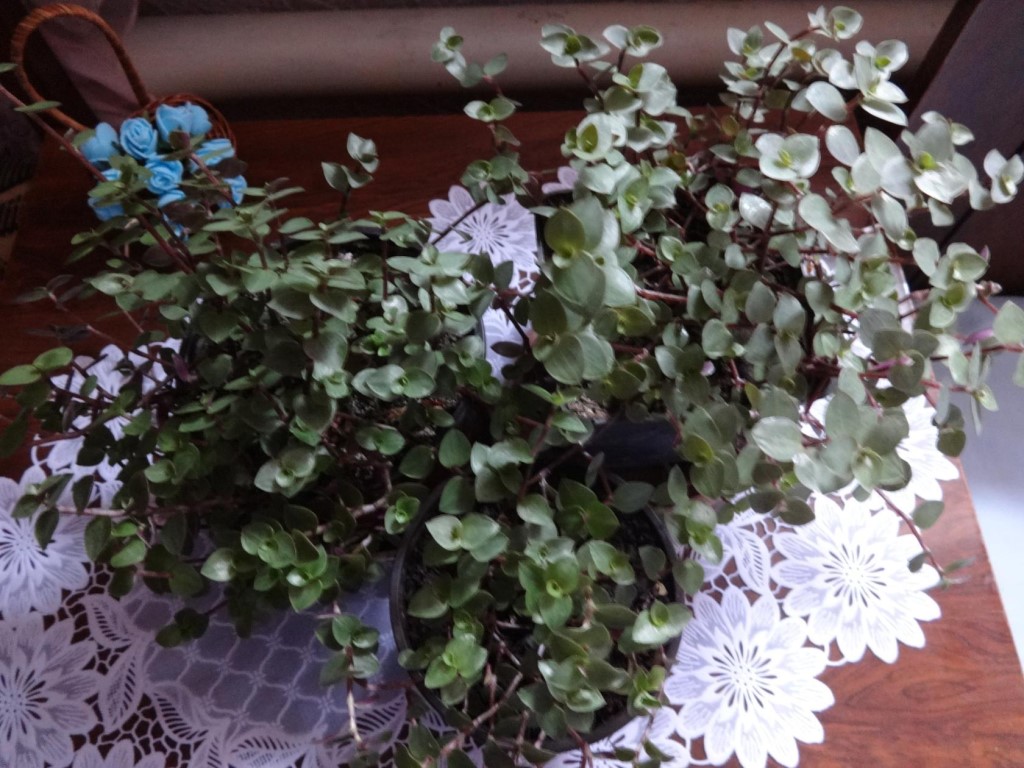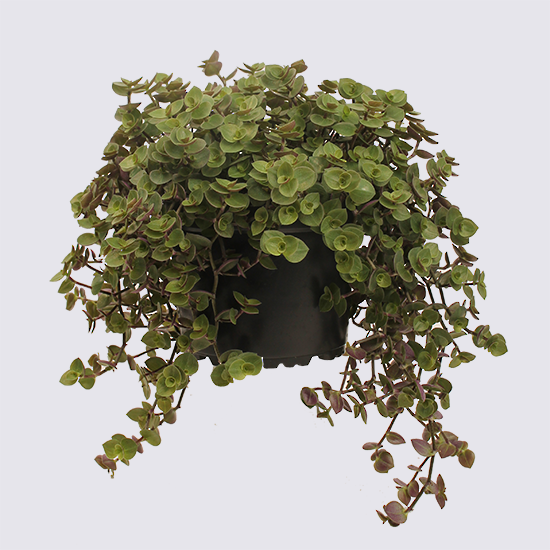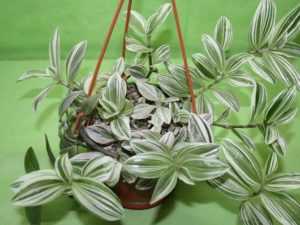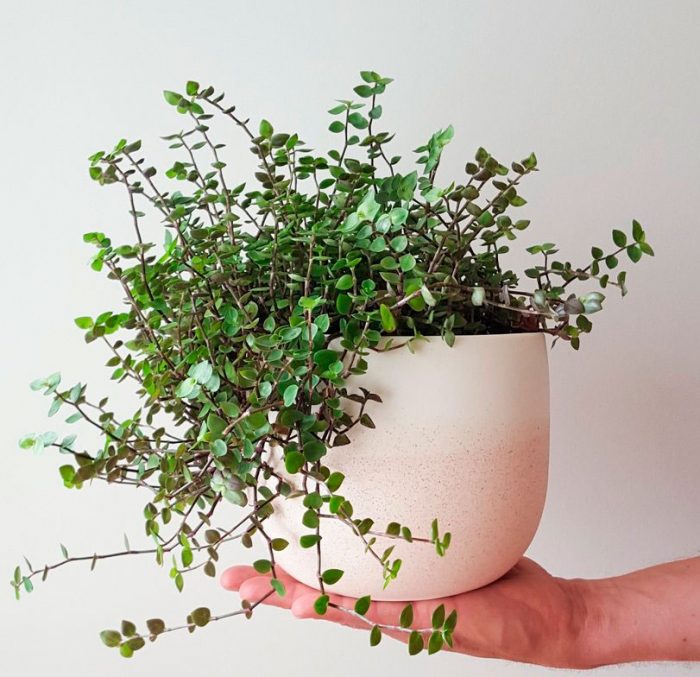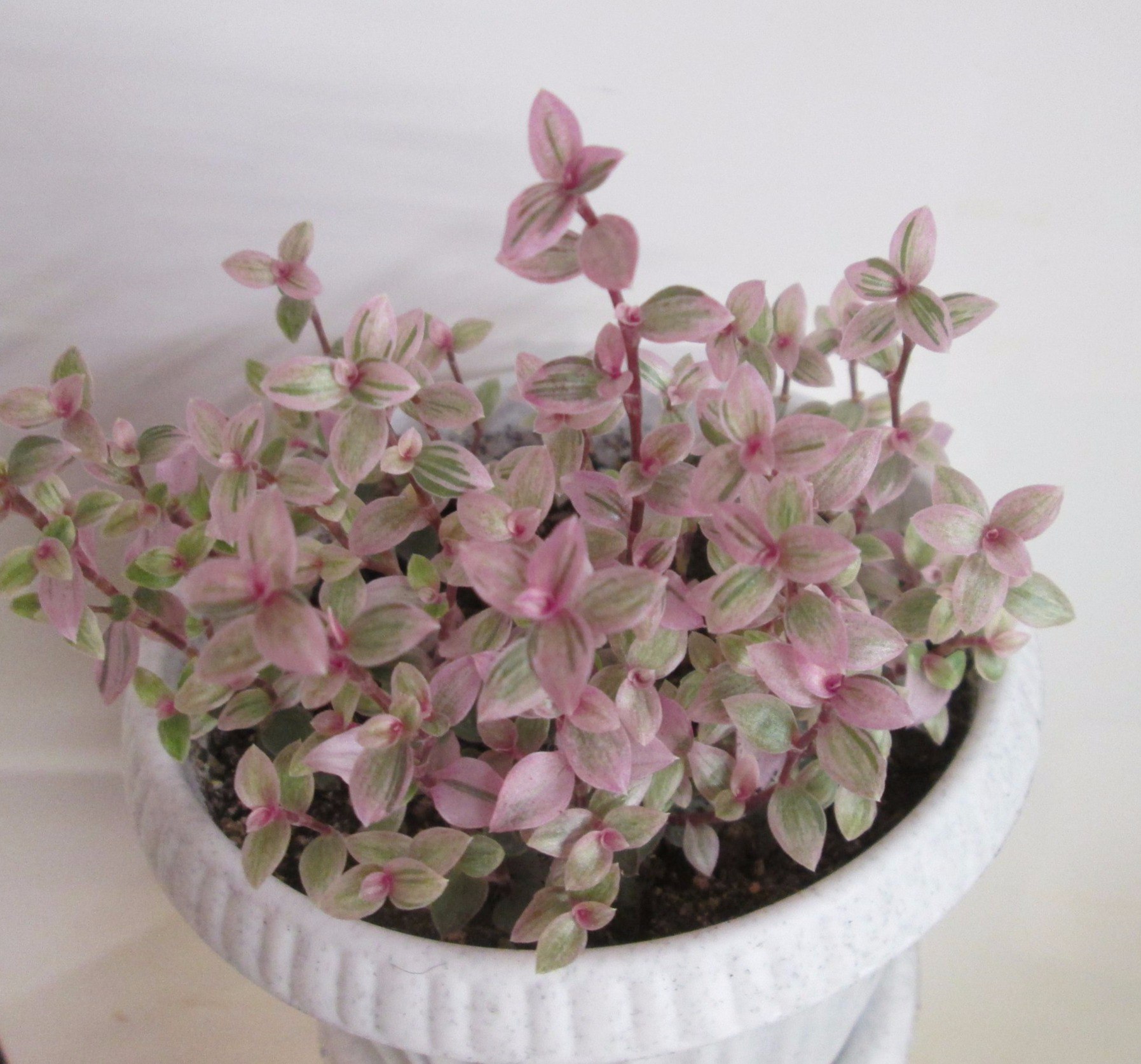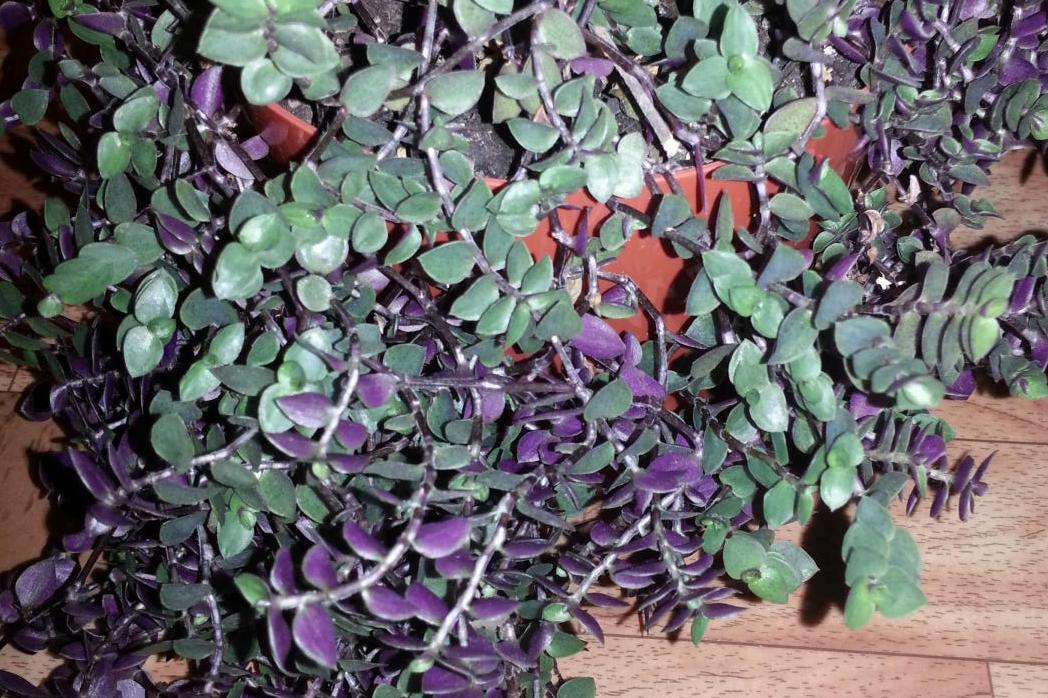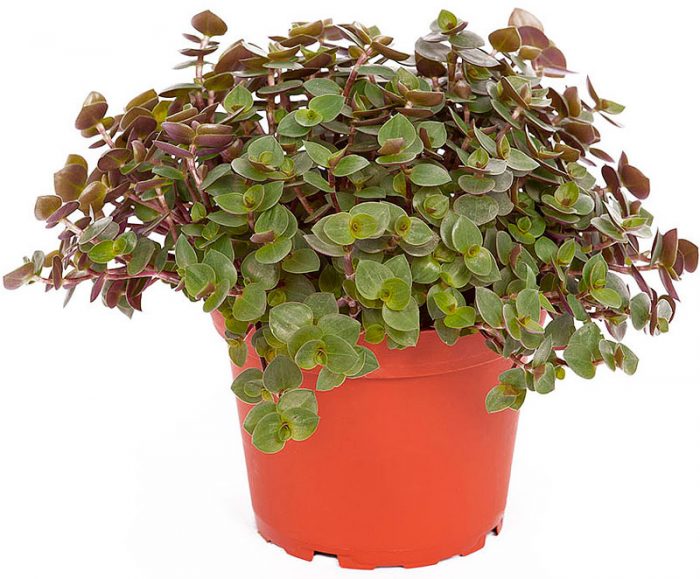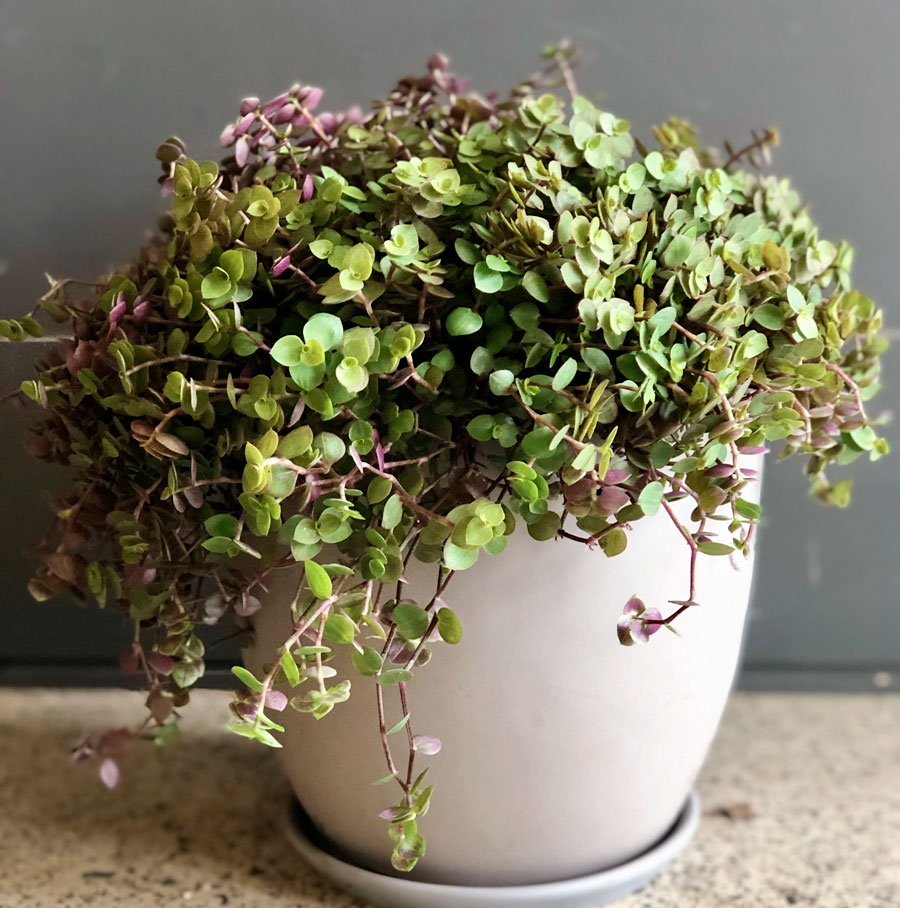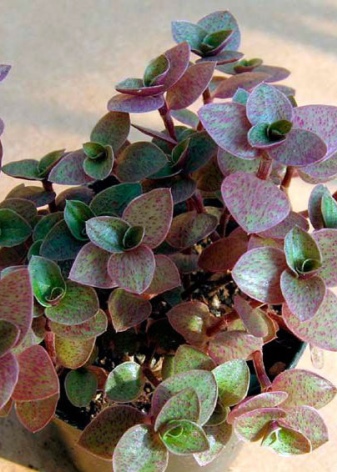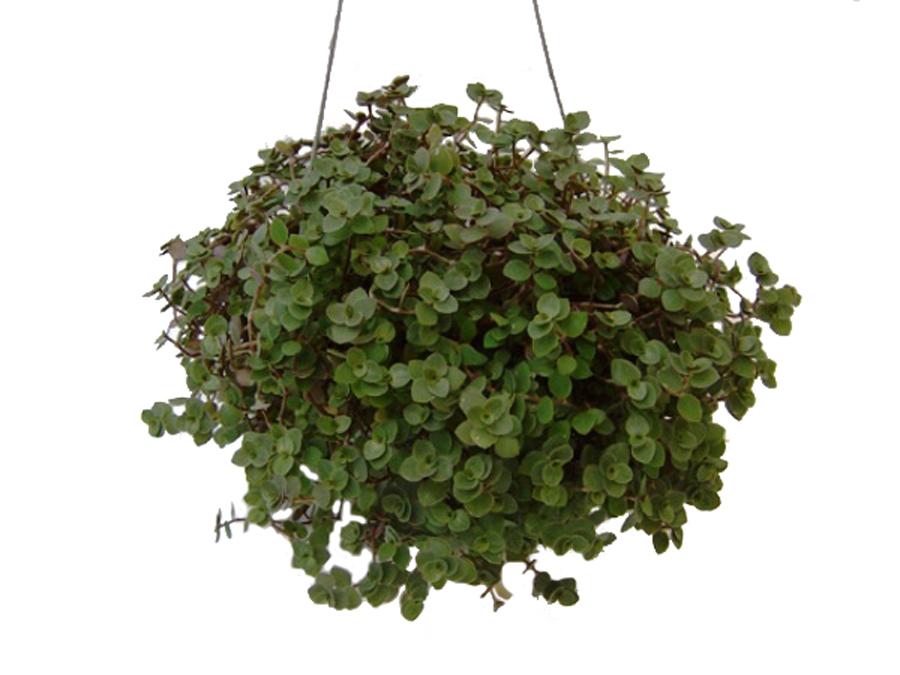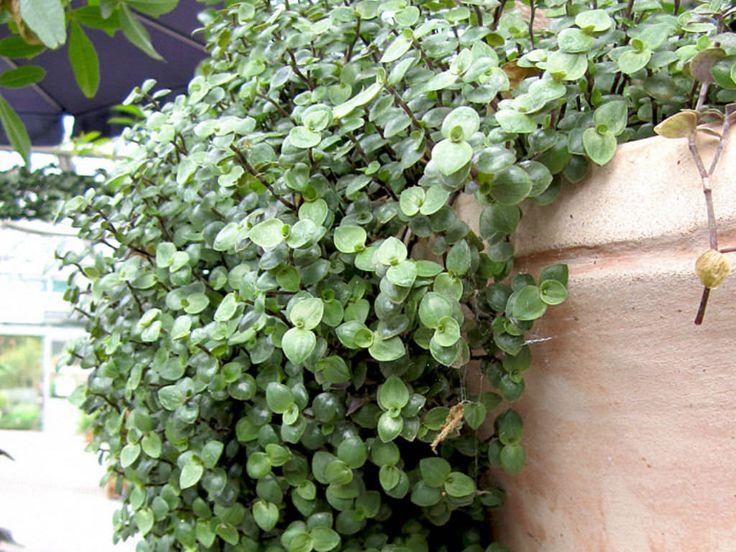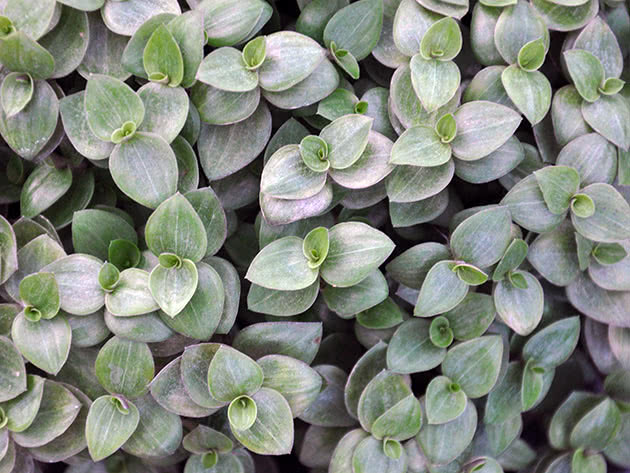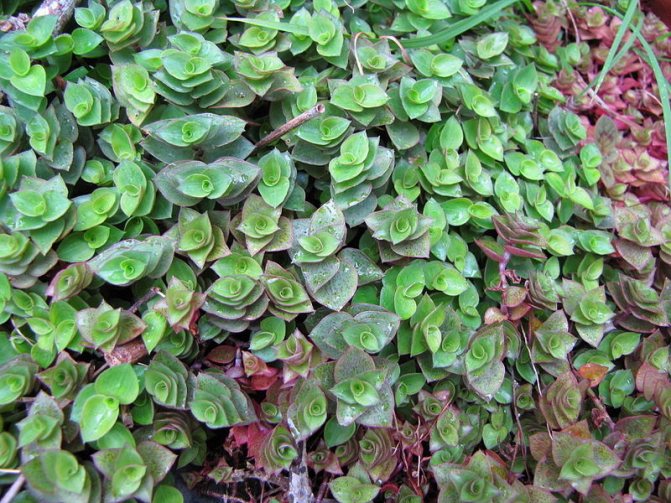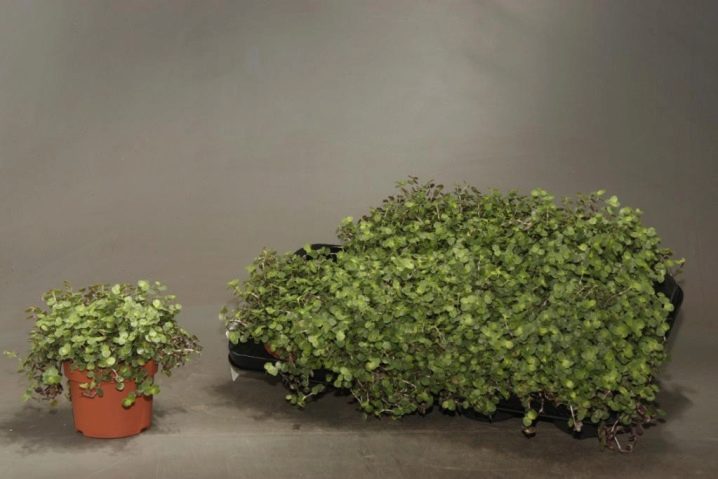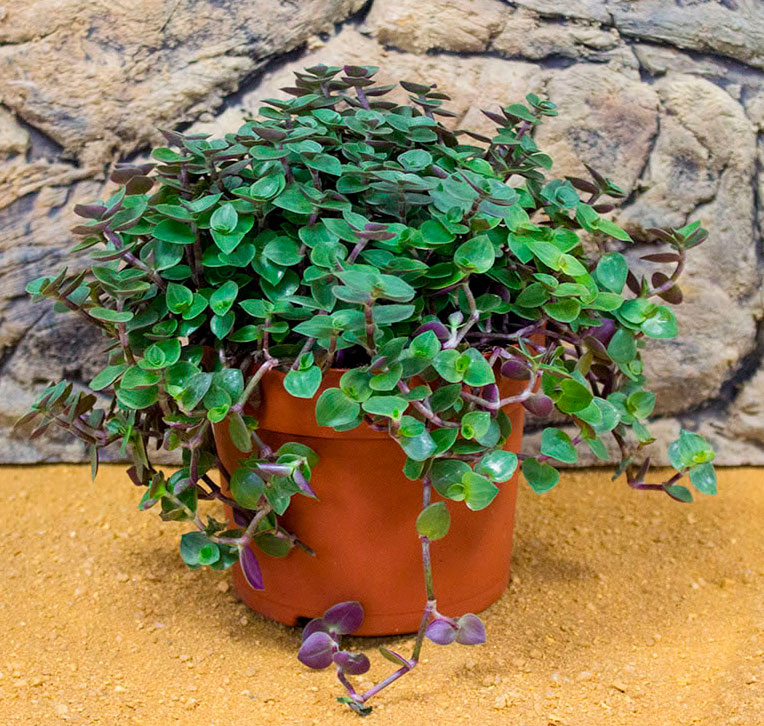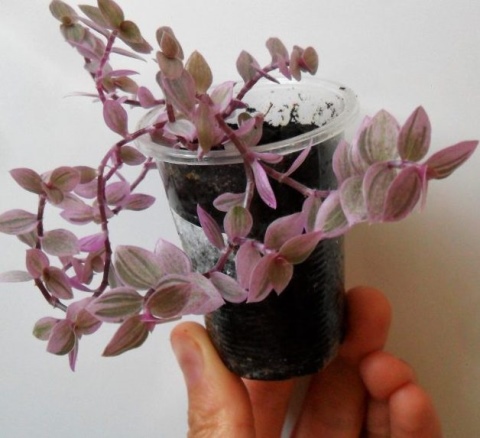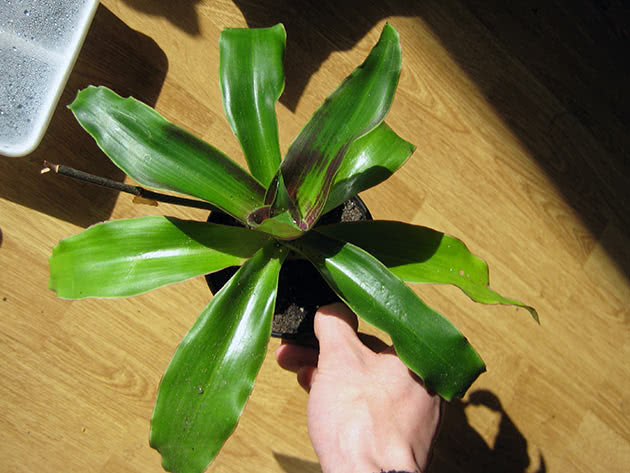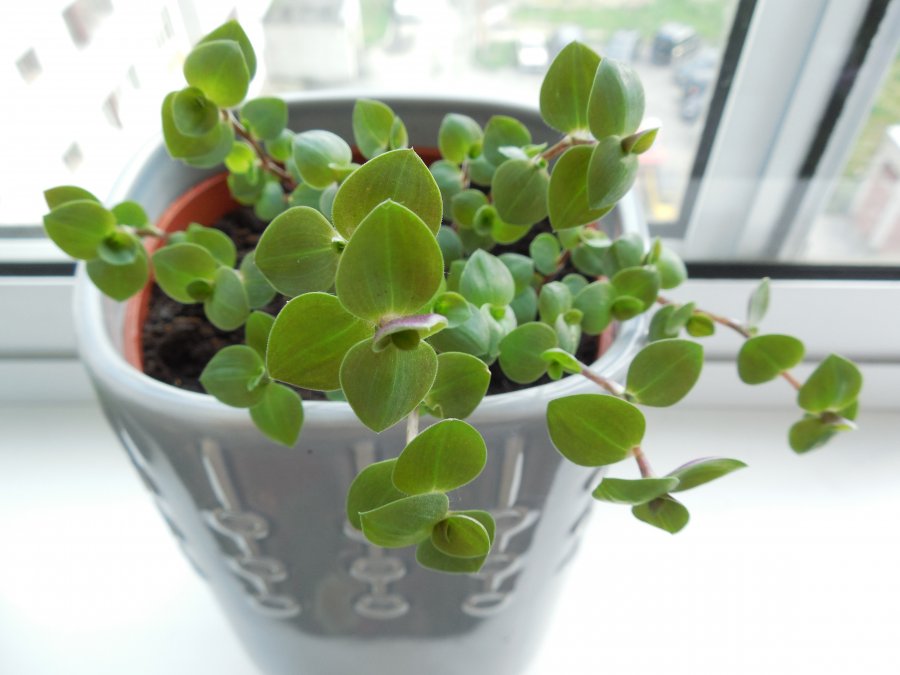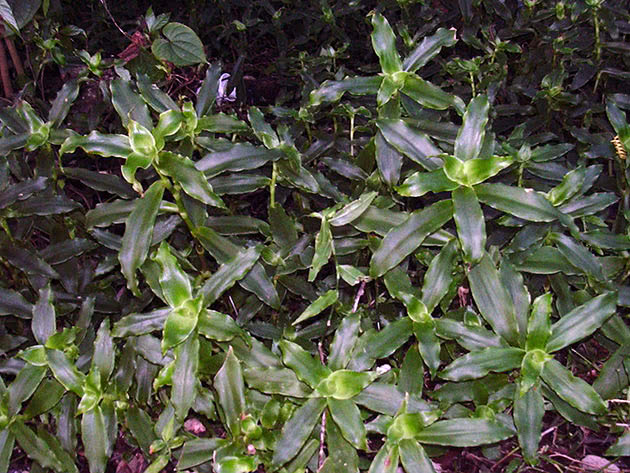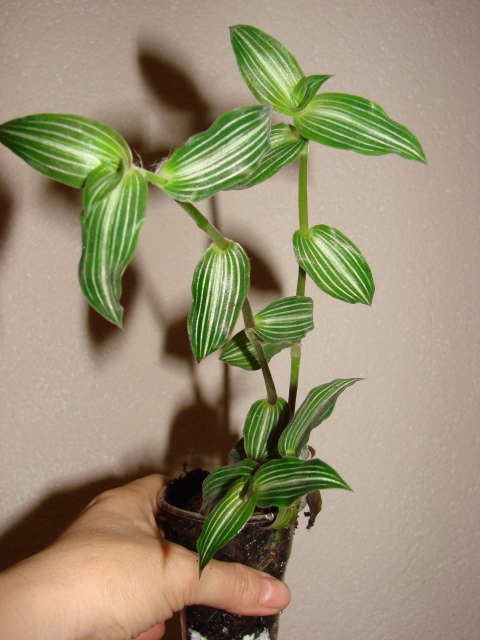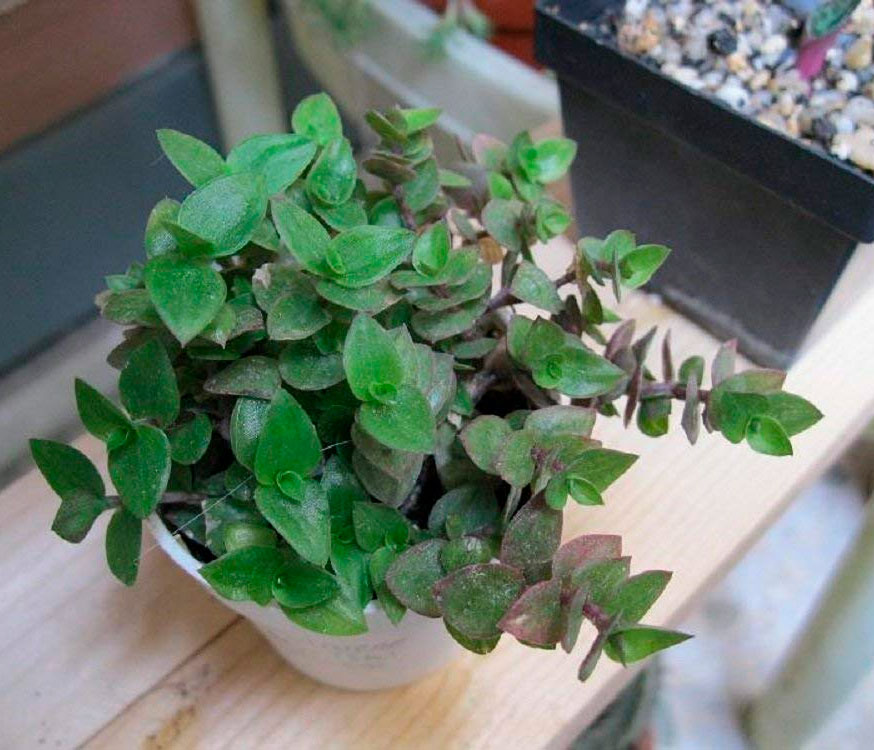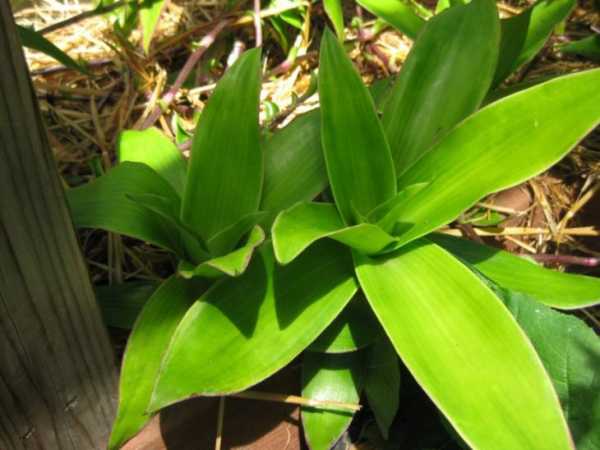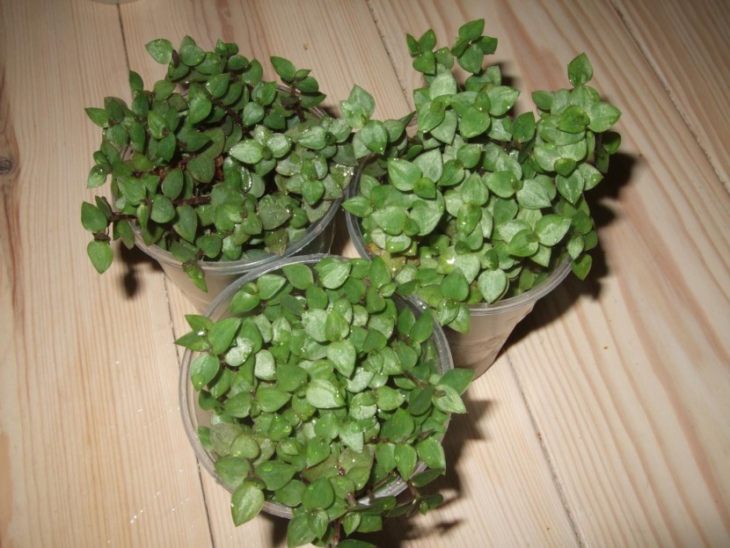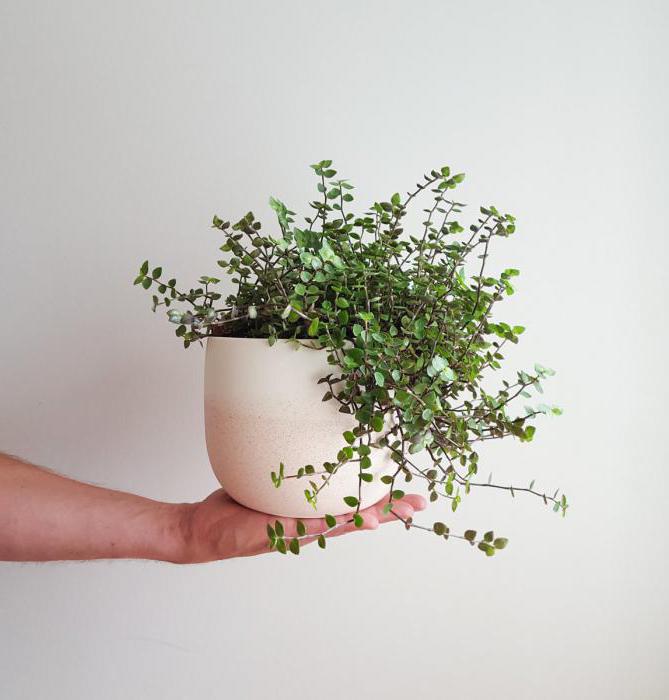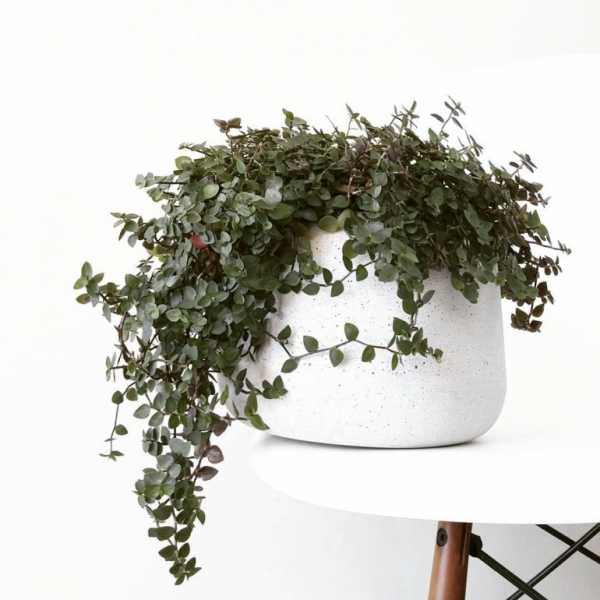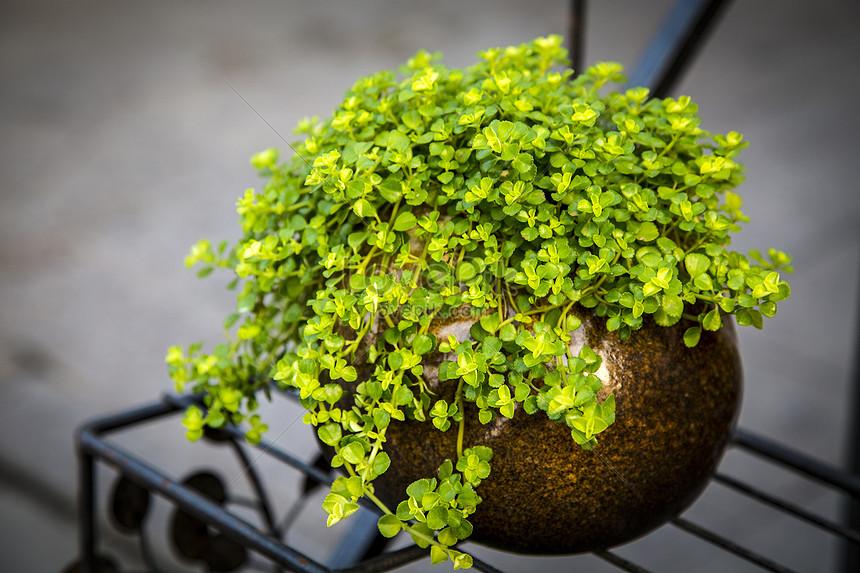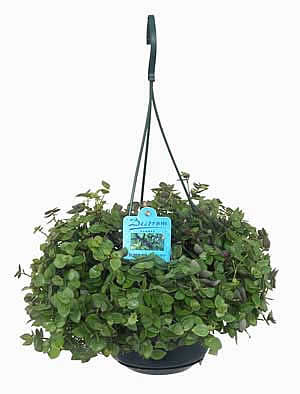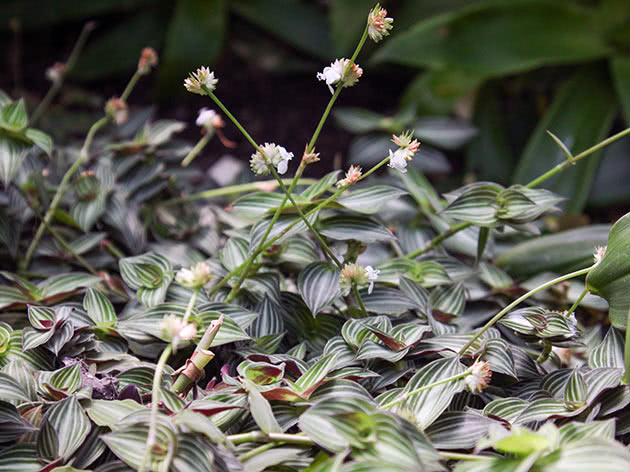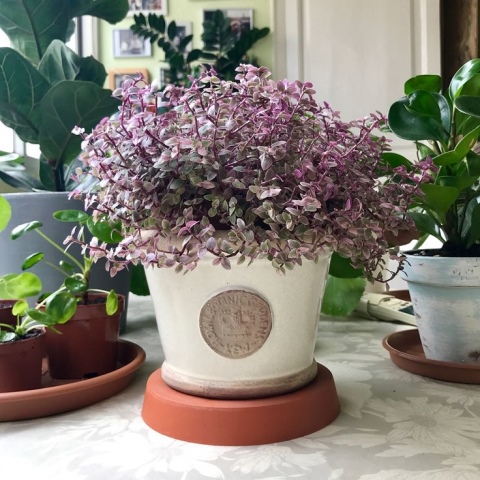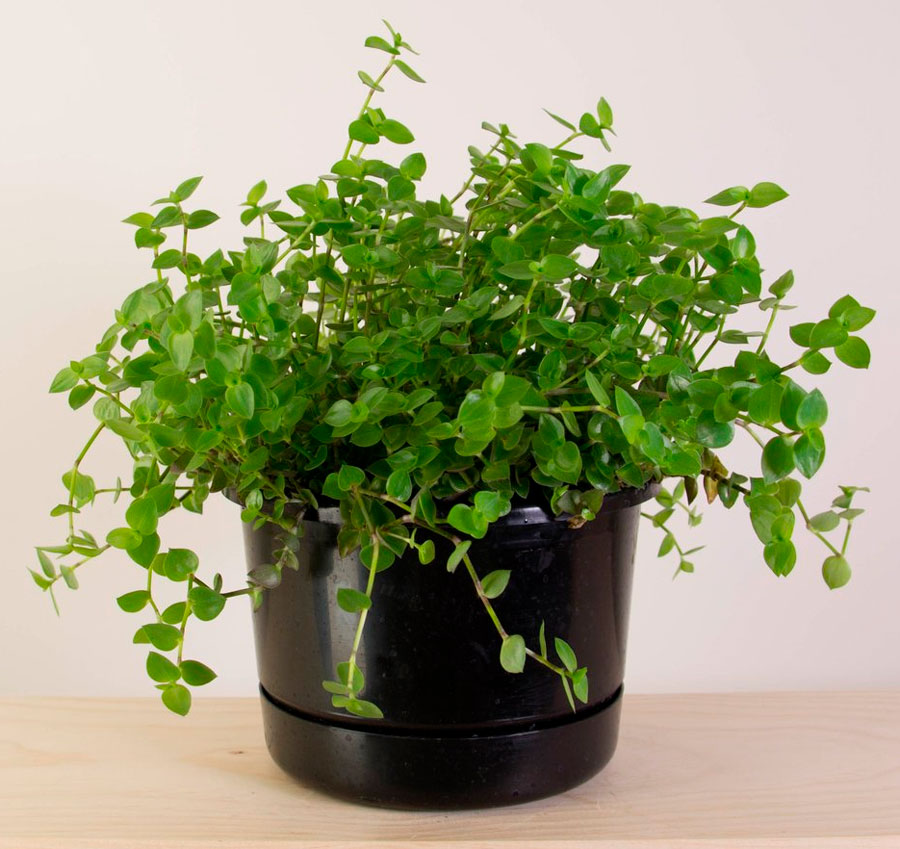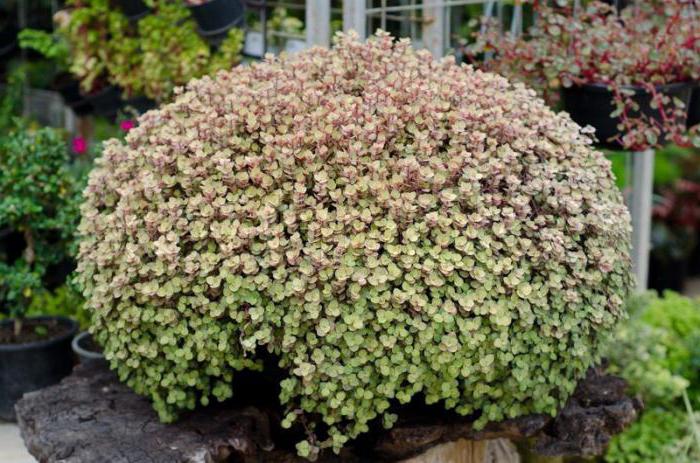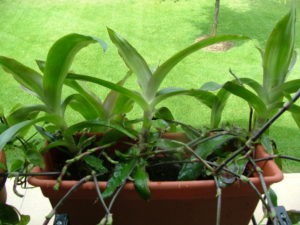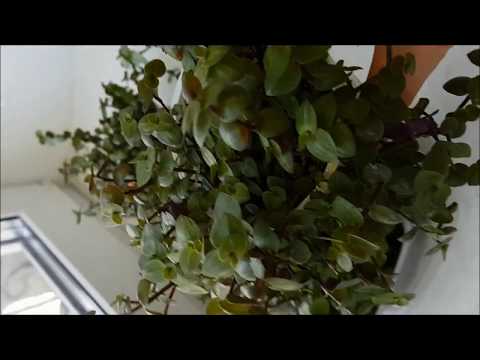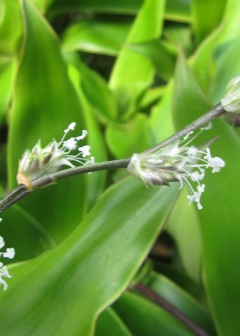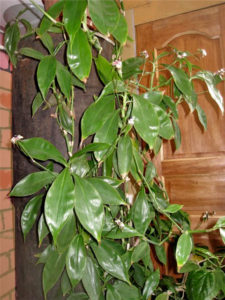Types and varieties of callisia
Or callisia graceful
- a miniature plant with geniculate creeping stems more than half a meter long, which first grow straight and then descend. This plant is very similar to Tradescantia. It reaches a height of 30-40 cm. Both the leaves and stems of the graceful callisia are covered with velvety pubescence. Oval, pointed at the ends, petiolate, up to 6 cm long, leaf plates of the plant are painted in a violet-green hue on the lower side, and dark green with silvery stripes on the upper side. This species blooms with white flowers that form at the ends of the shoots. The plant does not live very long: after two years, the leaves that lose their brightness in color no longer cover the shoot so tightly, so growers restore the vine by cuttings or layering.
 In the photo: Callisia elegans
In the photo: Callisia elegans
A changeable plant, the decorativeness of which depends on the variety and conditions of detention. It is a succulent with creeping stems that quickly take root at the nodes and juicy, lanceolate, strongly concave two-row leaves with a longitudinal groove, painted on the upper side in a bronze-green shade of red in the sun, and brownish-purple on the bottom. The leaves are bare, but along a line ascending from the sinus, fringed with small hairs, reaching 2 cm in length and 1.5 cm in width.
 In the photo: Callisia navicularis
In the photo: Callisia navicularis
The plant is up to 20 cm high and up to 30 cm wide with thin reddish or purple stems and small heart-shaped bright green leaves in purple specks arranged in two rows on them. The flowers of this species are white and inconspicuous. At home, callisia repens is grown in suspended structures, and in the garden it is used as a ground cover plant. Such garden forms of the species are known:
-
Bianca
- Callisia with red-violet delicate stems and small bright green leaves; -
Pink Panther
- variety with striped pink-green leaves.
The varieties of Callisia creeping Pink Lady, Noum Popula and Tortl are also popular.
 In the photo: Callisia creeping (Callisia repens)
In the photo: Callisia creeping (Callisia repens)
Or callisia thai,
or the golden mustache can also be found under the names of "Far Eastern mustache", "live hair", "homemade ginseng" and "corn". This is a larger plant than, for example, small-leaved creeping callisia grown at home. In height, fragrant callis can reach one and a half meters, but it definitely needs support, otherwise the vine can break under its own weight. Callisia fragrance has two types of stems: short, fleshy and vertical, ending in a large rosette of leaves, and long, tubular horizontal processes, articulated whiskers, which serve the plant to capture a new area. The leaves of this species are fragrant, large, leathery, dark green, up to 30 cm long and up to 6 cm wide.On the top side they are glossy, below they are matte, when grown in bright light, the leaves turn pink.
 In the photo: Callisia fragrans
In the photo: Callisia fragrans
Callisia
(Callisia) is a perennial herb that can be erect and creeping. It is very popular among lovers of indoor flowers.
Some species
are not only decorative, but also medicinal. These include fragrant Callisia (everyone knows Golden mustache
). At home, creeping and elegant Callisia is most often grown.
Callisia care at home
Since the natural habitat of callisia is tropical rainforests, the green beauty simply adores water and, therefore, needs it immensely. Thus, the plant is watered intensively. But this applies only to the period of active growth. Since autumn, the soil moisture under the flower is limited, in winter it is further reduced.However, make sure that the earthen lump does not dry out. In the same way, soil flooding is not allowed. For water procedures, use only soft moisture at room temperature.
From March until the end of the summer season, callisia is fed. For this purpose, a complex mineral concentrate is used as a fertilizer. Top dressing is done frequently, once a week.
Each time in the spring, the plant needs to be repotted while it is young. For a mature, change of substrate and pot is more rare - once every two years. The soil is used the same composition as at the time of planting exotic. Be sure to make sure that the soil has a slightly acidic reaction of the environment. At the bottom of the pot, arrange a high-quality layer of drainage material.
Applicable to callisia and rejuvenation procedure. It consists in re-rooting the apical shoots of the plant. This event is relevant due to the rapid so-called overgrowth.
New specimens of callisia are obtained by propagating the plant by cuttings. This is the simplest and most common method among florists. If you use apical shoots as propagation material, root them in an aquatic environment. If your choice fell on a horizontal stalk crowning the horizontal cut, carefully cut the shoot under the outlet and plant it in the nutrient soil, attaching the shoot to the ground with a special hook made of wood. Sprinkle the seedling with earth on top
As soon as the shoot takes root, it must be carefully separated from the main exotic and planted in another container, already in a permanent place
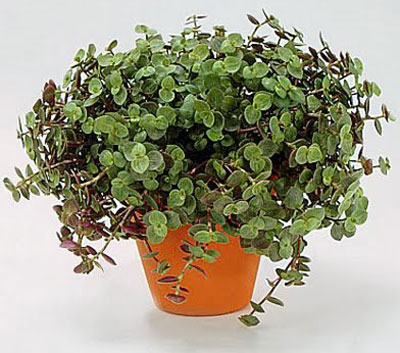
How to care for callis at home
The flower itself is not very picky, but still there are certain conditions that must be met for proper cultivation.
Seat selection
Choosing a place is a rather important stage when planting a plant. For callisia, it is necessary that the area is well lit, but it is better that direct sunlight does not fall. This can be a window sill, if the windows are not on the sunny side, the back of the room, a table, a shelf perpendicular to the window, etc.
It is important that there is good air circulation in the room.
There is no need to select a special soil, for example, you can take a substrate for succulents or any other
However, it is important that the soil is light. Watering should be done regularly and the amount of water should be increased during the spring-summer period, when the air temperature is very high.
For your information! Also, fertilizing with mineral fertilizers will be beneficial, mixing it into the water for spraying. The procedure should be carried out from May to September.
If the plant has grown very much, and there is no longer enough space in the pot, it must be transplanted. This can be done in two ways: transplant into a larger container or divide the plant into two parts.
Do not forget about cleaning yellowed or dry leaves, as well as damaged stems.
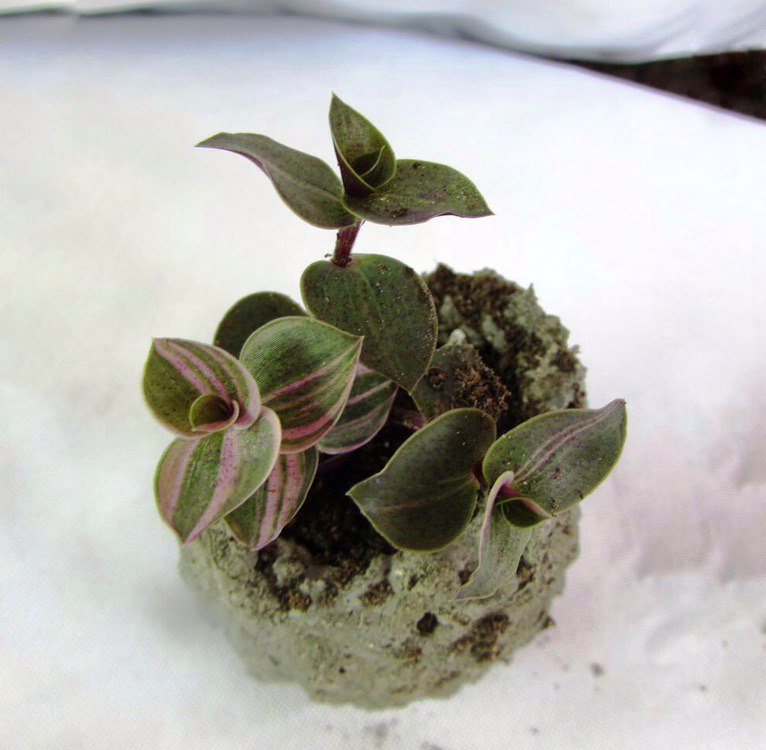
Transplanted callisia repens
Air temperature
For callisia, the best temperature is 20-25 ° C, so in summer it has no problems. In winter, it may be difficult to maintain the temperature regime, but if it is not lower than 16 ° C, then everything will be fine. Of course, the flower will slow down its growth, but it will not disappear.
Important! The air temperature can fluctuate, but if this happens abruptly, the plant will soon die
Air humidity
The need for water largely depends on the origin of the plant. Since callis is native to the subtropical and tropical regions of the United States, it needs high air humidity. In order for this plant to develop correctly, bloom and smell, it is necessary to spray it regularly (preferably every day) and not let the hot air blow on it, that is, it is not recommended to put the pots next to the radiator, heater, stove, etc.
2.Callisia care
Flowers, as a rule, are inconspicuous, appear in the summer.
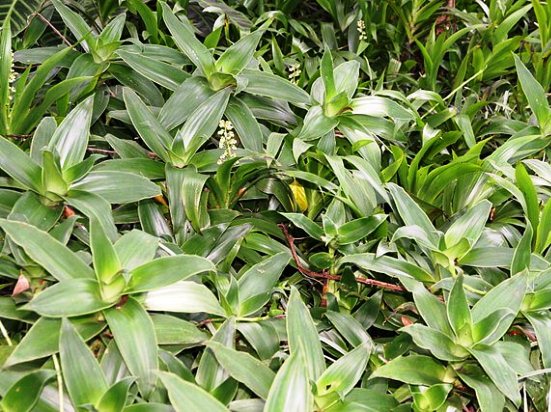
2.2 Diseases and pests
The tips of the leaves turn brown and dry out when there is insufficient air humidity. Decay with waterlogging and stagnation of water, especially in the autumn - winter period. When grown in low light conditions, the plants become loose and elongated, the leaves become smaller.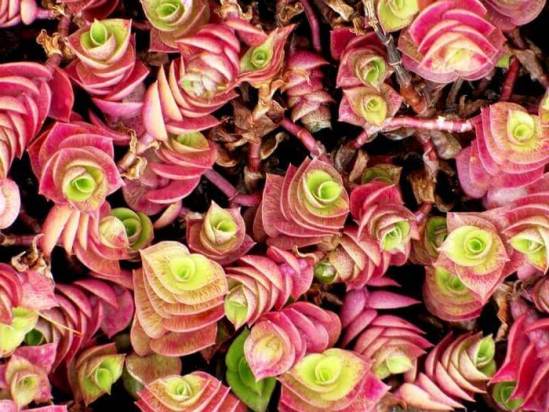
The most common pests are aphids, thrips, scale insects, mealybugs, whiteflies and red spider mites.
Insects are pests
| Insect name | Signs of infection | Control measures |
| Whitefly | Small light spots on leaf blades, yellowing and foliage falling off. Disturbed white, small butterflies take off from the surface of the leaves | Chemicals: Zeta, Rovikurt, INTA-VIR, Fufanol and even Karbofos, Actellik, Aktara, Confidor, Commander, Tanrek. Folk remedies: soap solution, garlic solution, infusion of yarrow and tobacco, infusion of dandelions, adhesive traps for adult insects |
| Mealybug or felt insect | The surface of the leaves and shoots is covered with fluffy, cotton-like white bloom. Plants are lagging behind | Folk remedies: spraying with soap and alcohol solution. Infusion of tobacco, garlic, cyclamen tubers, alcohol treatments, pharmaceutical tincture of calendula proved to be good. Chemicals: green soap solution, Actellik, Fitoverm. |
| Spider mite | Subtle spider webs on the leaves, yellowing and foliage falling off with extensive lesions. The surface of the sheet plates becomes dead and covered with small cracks. Plant development slows down. | Folk ways. Plants can be rinsed in the shower and left in the bathroom in a humid atmosphere for half an hour. Irradiation with an ultraviolet lamp every week for 2 minutes. Chemical preparations based on pyrethrum, sulfur powders, Fitoverm, Actellik. |
| Aphid | Sticky droplets appear on the leaf plates, the leaf plates curl and deform, delicate buds and young leaves wither. Insect colonies can be seen on the tops of the shoots, buds or the underside of the leaf plates. The flowers of aphid-infested plants may become deformed. | Folk methods: infusion of nettle, decoction of rhubarb leaves, wormwood, soap solution, infusion of tobacco and dandelion, onions, marigolds, yarrow, tansy, dusting with wood ash. Chemical preparations: Sulfur powders, green mass treatment with green potash soap without getting into the ground, Decis, Aktellik, Fitoverm. |
| Thrips | The appearance of yellow spots on the leaf blades, small brown dots can be observed on the underside of the leaves. When spread, the pests cause the leaves to turn yellow, dry and fall off. | Folk ways. Increase the humidity of the air, wipe the surface of the leaves with soapy water to reduce the number of pests. Preparations based on pyrethrum - 2-fold treatment with an interval of 7 - 10 days, spraying with tobacco infusion, infusion of yarrow or Persian chamomile, decoction of cyclamen tubers. Chemical preparations: dusting with sulfur powders, the use of anabazine - sulfate in a soapy solution. |
| Shield and false shield | Sticky droplets on the leaves, small yellow spots on the surface of the leaf plates. With a large spread of scale insects, they contribute to the drying and falling of leaves. Flowers slow down their development | Folk methods of struggle. Spraying with soap and alcohol solution. Scabbard larvae do not like garlic infusion; they also use pyrethrum-based products. Chemicals. Fitoverm, Aktellik, Fufanon. |
-
Whitefly
-
Mealybug
-
Spider mite
-
Aphid
-
Thrips
-
Shield
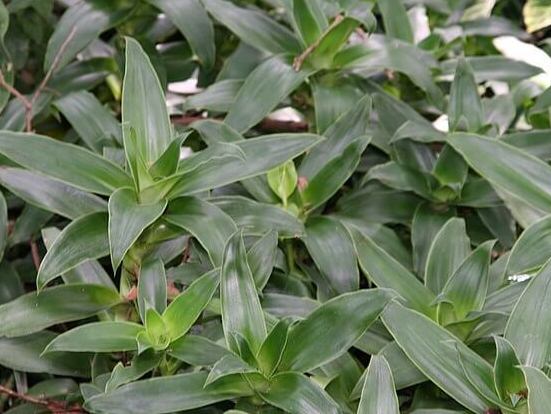
2.3 Growing in the house
Pinch the tips of young shoots regularly to keep the plant compact. If you do not prune, the plant will look untidy. Remove too green leaves in time, which also spoil the appearance of the plant.Place the callisia outdoors during the summer months, with cover from strong gusts of wind and rain.

2.4 Reproduction of callisia
Callisia is a close relative of Tradescantia and also propagates by cuttings taken in the spring. Cut the cuttings 5 to 10 cm long and remove the lower leaves from them. Root in a damp mixture of peat and sand, or in a simple glass of water. Powdered growth hormones can be used for rooting. Cover young plants with a clear plastic cover or glass to maintain moisture and place in a warm place in partial shade. Rooting takes 2 - 3 weeks.
Care
Location and lighting
Its variegated color requires diffused lighting and does not tolerate direct sunlight. The plant can be safely placed in the back of a bright room; callis is suitable for both offices and very large rooms. Window sill - west or east window, be sure to shade in bright sun. To ensure that the plant grows evenly, turn the pot to the light with a new side every week.
If the room is smoked and not ventilated, the callisia will not last long there. Open the vents more often, and in the summer, take the plant out to an open balcony or outside.
Temperature
Callisia is thermophilic, so a suitable temperature for winter is not lower than +14 degrees, in summer - + 20-25 degrees. Cannot withstand sharp drops in temperature. Do not place the flower near heating appliances; cover the radiators with blankets.
Watering
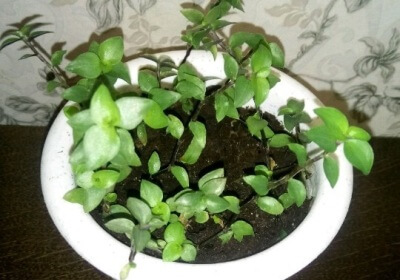 Watering - as the top layer of the soil dries up (both in spring and summer), regularly, preferably in the evening hours. In winter, you need to water less often, but again - do depending on the ambient temperature.
Watering - as the top layer of the soil dries up (both in spring and summer), regularly, preferably in the evening hours. In winter, you need to water less often, but again - do depending on the ambient temperature.
Water for irrigation callisia is suitable for soft, purified from harmful impurities and chlorine. Of course, not immediately from the tap. Train yourself to pre-settle the liquid for several hours in a container without a lid.
Humidity
Air with a high level of humidity is suitable for callisia, so regularly spray the leaves with a spray bottle and brush dust from the plant with a soft brush (or wipe with a damp soft sponge).
Transfer
Young specimens should be transplanted every spring, mature - every two years... The composition of the soil should always be the same.
Prepare the planting soil yourself: mix one part of the leaf and sod land, peat, humus and sand. Do not forget to disinfect the mixture by calcining it in the oven or keeping it in the freezer for 24 hours. Be sure to lay a drainage layer of 1.5-2 cm on the bottom of the pot (expanded clay or small pebbles, broken shards).
Plant care
Callisia care is not difficult and will not take much time. In terms of growth rate, according to the scale of professional florists, it belongs to the middle class. Follow the recommended care instructions for the Callisia flower, and the house will be decorated with a fluffy charming plant.
Care conditions
Lighting and location
Callisia is not a plant for south-side windowsills during hot weather. She is a lover of light, but at the same time avoids contact with the sun's rays directly. (In the same conditions, Heteropanax grows well.) A favorable place for a flower pot is a stand, away from the scorching sun, or east and west windows. A completely shady location is also contraindicated, because leaves lose their attractiveness, fade. Pay one more thing, callisia does not like kitchen, tobacco and foreign odors. The most comfortable place for location is an office, an office, and in the summer season - a balcony, veranda, loggia.

Indoor temperature
For a houseplant callisia, moderate warm air is suitable. In winter, it will calmly withstand a slight cold snap, but not lower than + 15 ° C. On hot days, the temperature should not exceed 25 °. She is not very capricious to temperature changes, but sharp plants are contraindicated.
Air humidity
Callisia does not like dryness in the air, and loves procedures in the shower with a weak diffusing pressure of water.Monitor the humidity in the room where callis grows, ventilate and spray regularly. It is good if there is a container with water or humidifiers programmed for a level of 60-70% humidity near the flower pot. Large leaves of the plant are wiped from dust with a damp cloth.
Watering callisia
Using a toothpick or any other wooden stick, check the need for watering the plant. If the soil is dry at a depth of 3-4 cm, it is time to water the callisia. Watering is done closer to the edges of the flowerpot rather than the center of the plant to avoid rotting. Use filtered or soft rainwater, tap water is defended within 24 hours. Water the plant abundantly, sparing in winter and less often.
Pruning
Pruning callisia should be carried out regularly, cleaning time is in spring. Dry shoots and mustache babies should be completely eliminated. Pruning helps the callis to retain its shape and properties. Pruning for a plant is a painless process.
Fertilizer and feeding
From spring to autumn, it is time to fertilize the plant. Top dressing is prepared from a complex of minerals, the procedure is performed once or twice a month.

Plant propagation
Transfer
Most flower growers do not transplant, callisia retains its attractiveness for a long time. But if you decide, then replant no more than once a year or less often, according to standard rules - damaged stems and leaves are removed, freshly preserved ones are planted in the soil on the drainage.
Reproduction
Cut off the tops of the plant with two or three nodules, put the cuttings for rooting in water. After the cuttings begin to develop, plant several pieces in one flower pot in the ground. For layering, dig in the third nodule before rooting. Then separate from the main plant and plant in a separate pot. Callisia successfully reproduces with a mustache. Callisia can be propagated at any time of the year.
Priming
The basis of the soil is drainage and nutrient soil. The composition of the nutrient soil includes part of the sod land, 3 parts of humus and 1 part of coarse sand.
You will be interested in:
Pests, diseases and problems of callisia
The plant, by its very nature, has good immunity to diseases, and pests usually do not disturb it. But problems, nevertheless, arise with improper care. In particular:
- With a lack of light, the plant begins to stretch.
- Few fertilizing - the growth of callis slows down.
- The lack of minerals will affect the pallor of the leaf.
- Callisia will react to a decrease in temperature, the leaves will lose their elasticity and become soft.
- When watering, the plants were allowed to get into the core - the leaves would rot.
- With dry indoor air, brown, painful spots will appear on the callis leaves.
- Of the pests that can cause damage to the plant, scale insects, spider mites, aphids are noted.

Reproduction
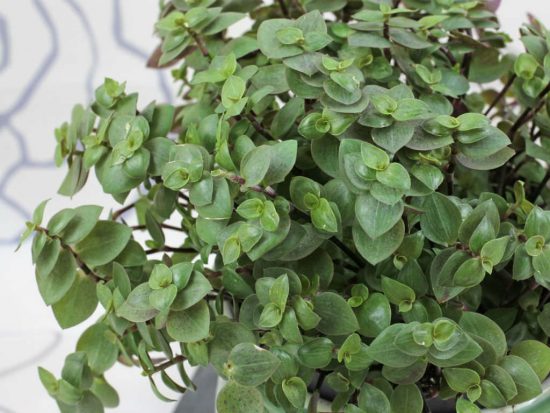
Callisia is propagated using cuttings, layering and mustache. Cuttings are carried out in the spring. For the procedure, only those processes are suitable on which at least 10 nodes have grown. Then the upper part is cut off two "joints" below, where the middle of the third is located. The cuttings are placed in water and covered with a plastic cup. After about 2 weeks, the scion takes root. After that, the young plant is planted in the ground.
Layers can be planted in a pot with the mother plant or separately if there is not enough free space. The shoot is pressed and covered with earth at the level of 3 knots. After the roots appear, the cuttings are separated from the mother plant. Breeding with whiskers is also easy. Some varieties at the end of the latter form small shoots with roots. They are cut and planted in separate containers.
Transfer
Some experts recommend planting a new flower instead of transplanting. This is due to the fact that the stems of the plant become bare with age and its decorative effect decreases.If the flower lives in the house for a long time, they are accustomed to it, then it is better to transplant it. With young plants, this is done annually, and with adults - after two to three years. How to proceed, the florist decides.
You need to transplant the plant into another container with good drainage and new soil. This can be done throughout the year, but it is better in the spring. You can prepare the soil yourself. To do this, in equal proportions, sod and leaf land from the garden, humus, peat and sand are taken.

The healing and other useful properties of callisia
The medicinal properties of plants from the Commelin family have interested scientists in the middle of the 20th century. In the course of studies that were started in America and Canada, experts found that callisia juice contains a large amount of biologically active substances that inhibit the development of cancer cells.
As for the golden mustache, in Russia, research on the properties of this plant began in the early 1980s at the Irkutsk Medical Institute. For many years, scientists under the leadership of Professor Semenov, famous in Russia, tried to uncover the secret of callisia and, I must say, they almost succeeded.
As a result of numerous experiments, it was proved that the golden mustache really has medicinal properties, due to the high content of biologically active substances, but at the same time, the use of this medicinal plant leads to some side reactions of the body, in particular, to damage to the vocal cords and allergic rashes and edema. (in people with weakened immunity and with a hereditary predisposition to allergies). That is why the use of preparations of the golden mustache is permissible only after consultation with a specialist.
Callisia juice contains two representatives of flavonoids (a group of natural biologically active compounds): quercetin and kaempferol. The content of the highly active substance beta-sitosterol in callisia helps to actively fight diseases such as atherosclerosis, metabolic diseases, endocrine system diseases, inflammation of the prostate gland and many others. Callisia is also rich in vitamins and minerals, which, in combination with bioactive substances, become more effective.
Due to the presence of biologically active substances, callisia is able to fight all sorts of infections, stimulate metabolic processes, strengthen the circulatory system and immunity, promote the elimination of toxins from the body, and have an analgesic, wound healing and antitumor effect. It is used to treat diabetes mellitus, leukemia, chronic pancreatitis, osteochondrosis, female diseases, restore the function of the pancreas, spleen, adrenal cortex, relieve inflammation of the gallbladder and biliary tract, stomach, small intestine, normalize the acid-base composition of the gastrointestinal tract, dilution of sputum, reduction of hypersecretion and edema of the bronchial mucosa in asthmatics. External use has an effect on the healing of trophic ulcers, soothes pain in deep burns, heals them, heals frostbitten limbs, heals skin diseases well.
According to some reports, the fragrant callis plant releases phytoncides into the air, which have antiseptic properties.

